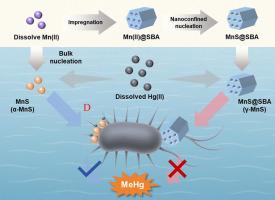Nanoconfined metastable manganese sulfide in mesoporous silica enables effective suppression of microbial mercury methylation
IF 12.4
1区 环境科学与生态学
Q1 ENGINEERING, ENVIRONMENTAL
引用次数: 0
Abstract
Mercury contamination in aquatic ecosystems poses a persistent threat to human health, primarily due to the formation of the highly toxic and bioaccumulative methylmercury (MeHg). Conventional remediation strategies (e.g., adsorption, precipitation) often fail to prevent MeHg generation as the immobilized mercury remains bioavailable to methylating microorganisms. Here, we develop a manganese sulfide-mesoporous silica composite (MnS@SBA) that leverages nanoconfinement within the silica channels to stabilize the metastable γ-MnS phase, thereby enhancing mercury sequestration while effectively suppressing microbial methylation. The MnS@SBA exhibits exceptional Hg(II) sequestration efficiency across diverse environmental conditions (e.g., pH, redox conditions, dissolved organic matter, coexisting ions). Spectroscopic and microscopic analyses, combined with theoretical calculations, reveal that nanoconfinement promotes strong Hg–S interactions and facilitates HgS precipitation within the silica channels, minimizing mercury bioavailability. Crucially, MnS@SBA prevents contact between immobilized mercury and microorganisms, effectively suppressing microbial MeHg production. Composed of low-cost, naturally abundant components and superior performance in simultaneous Hg(II) removal and MeHg suppression, MnS@SBA presents a promising and practical material for mitigating mercury pollution in aquatic environments. This study establishes a novel framework for designing nanoconfined functional materials that simultaneously achieve metal remediation and ecological risk mitigation, offering insights for designing advanced materials targeting heavy metal contaminants.

介孔二氧化硅中的纳米亚稳硫化锰能够有效抑制微生物汞甲基化
水生生态系统中的汞污染对人类健康构成持续威胁,主要是由于高毒性和生物蓄积性甲基汞的形成。传统的修复策略(如吸附、沉淀)往往不能防止甲基汞的产生,因为固定的汞仍然是甲基化微生物的生物可利用性。在这里,我们开发了一种硫化锰-介孔二氧化硅复合材料(MnS@SBA),该复合材料利用二氧化硅通道内的纳米约束来稳定亚稳的γ-MnS相,从而增强汞的固载,同时有效地抑制微生物甲基化。MnS@SBA在不同的环境条件下(如pH值、氧化还原条件、溶解的有机物、共存的离子)均表现出优异的汞(II)固存效率。光谱和微观分析结合理论计算表明,纳米限制促进了强Hg-S相互作用,促进了hg在二氧化硅通道内的沉淀,最大限度地降低了汞的生物利用度。至关重要的是,MnS@SBA可防止固定汞与微生物接触,有效抑制微生物MeHg的产生。MnS@SBA具有低成本、天然丰富的成分和同时去除Hg(II)和MeHg的优异性能,是一种有前景的实用材料,可用于减轻水生环境中的汞污染。本研究为设计纳米功能材料建立了一个新的框架,同时实现金属修复和生态风险缓解,为设计针对重金属污染物的先进材料提供了见解。
本文章由计算机程序翻译,如有差异,请以英文原文为准。
求助全文
约1分钟内获得全文
求助全文
来源期刊

Water Research
环境科学-工程:环境
CiteScore
20.80
自引率
9.40%
发文量
1307
审稿时长
38 days
期刊介绍:
Water Research, along with its open access companion journal Water Research X, serves as a platform for publishing original research papers covering various aspects of the science and technology related to the anthropogenic water cycle, water quality, and its management worldwide. The audience targeted by the journal comprises biologists, chemical engineers, chemists, civil engineers, environmental engineers, limnologists, and microbiologists. The scope of the journal include:
•Treatment processes for water and wastewaters (municipal, agricultural, industrial, and on-site treatment), including resource recovery and residuals management;
•Urban hydrology including sewer systems, stormwater management, and green infrastructure;
•Drinking water treatment and distribution;
•Potable and non-potable water reuse;
•Sanitation, public health, and risk assessment;
•Anaerobic digestion, solid and hazardous waste management, including source characterization and the effects and control of leachates and gaseous emissions;
•Contaminants (chemical, microbial, anthropogenic particles such as nanoparticles or microplastics) and related water quality sensing, monitoring, fate, and assessment;
•Anthropogenic impacts on inland, tidal, coastal and urban waters, focusing on surface and ground waters, and point and non-point sources of pollution;
•Environmental restoration, linked to surface water, groundwater and groundwater remediation;
•Analysis of the interfaces between sediments and water, and between water and atmosphere, focusing specifically on anthropogenic impacts;
•Mathematical modelling, systems analysis, machine learning, and beneficial use of big data related to the anthropogenic water cycle;
•Socio-economic, policy, and regulations studies.
 求助内容:
求助内容: 应助结果提醒方式:
应助结果提醒方式:


